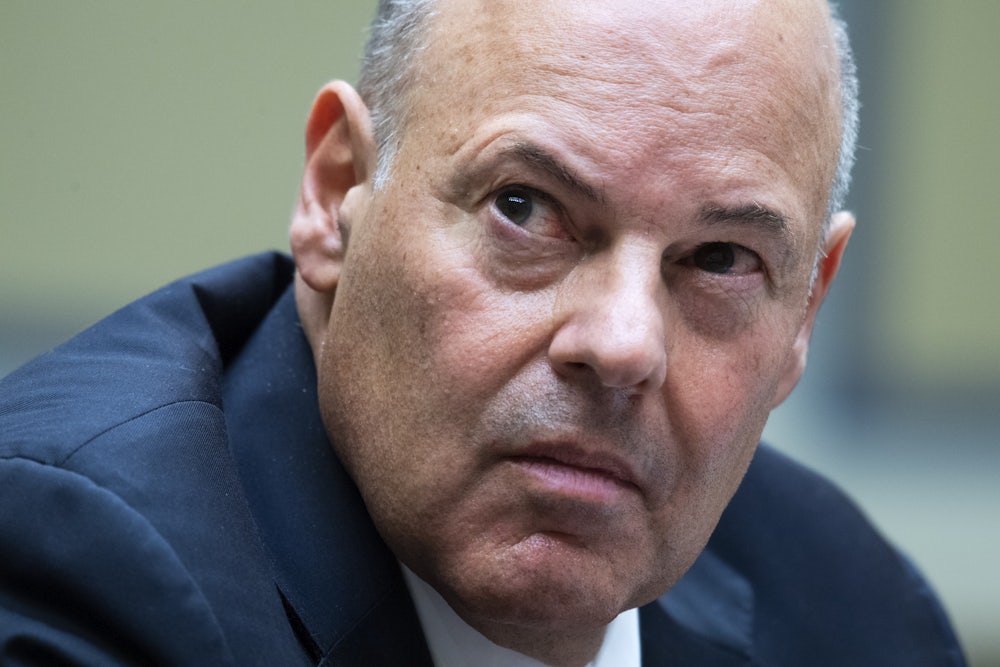If you’ve sent or received any mail over the last few months, you may have noticed that the United States Postal Service is not in great shape. After Louis DeJoy, a Republican fundraiser, took over as postmaster general last June, he quickly implemented a series of “reforms” seemingly designed to slow down service, leading to precipitous declines in the speed with which mail was delivered. Over the holidays, fewer than 40 percent of letters arrived on time.
The USPS is a popular agency and, for many Americans, a vital one. Wrecking it directly harmed or inconvenienced millions of Americans in ways Donald Trump’s other acts of sabotage and corruption never did. Now, with a Democratic president, it would seem like the first thing to do to begin repairing the USPS would be to fire its chief wrecker, DeJoy.
Except President Joe Biden can’t. At least, that is what the experts say.
The issue is that the USPS is designed to be a functionally independent agency, run like a corporation. Its governing body is the Board of Governors of the United States Postal Service. Only the board can remove a postmaster general. The governors are appointed by the president and approved by the Senate, and they then serve fixed terms.
The goal of this setup was to shield the USPS from political interference by, for example, comically corrupt presidents. As Aaron Mak and Mark Joseph Stern put it in a helpful Slate explainer:
Once confirmed to the board, governors can only be removed by the president “for cause”; that means their jobs are safe unless the president can show that they engaged in malfeasance or extreme neglect of duty. The board of governors, in turn, selects the postmaster general, who is not subject to Senate approval. And once appointed, the postmaster general can only be removed by the board, though it need not justify its decision.
Ah, but! Surely governors can be fired “for cause” if they abetted the deliberate sabotage of the core mission of the USPS, right? That is what some Democrats in Congress have already argued. Representative Bill Pascrell wrote Biden a letter last month in which he urged the president to fire the governors because their “refusal to oppose the worst destruction ever inflicted on the Postal Service was a betrayal of their duties and unquestionably constitutes good cause for their removal.”
It is not that simple, unfortunately. As Slate explains, “Legal experts question whether this theory would hold water in court.” According to one law professor, “Allowing a president to decide that he doesn’t like what the agency as a whole is doing as a justification for firing its entire board would be a very hard sell in court.”
So, while firing governors “for cause” may seem like a slam dunk to you or me, the legal community doesn’t expect the judiciary to agree, as the cause would have to be specific individual acts of obvious malfeasance.
After all, that is what the statute says. Does there happen to be any precedent—very recent precedent, perhaps—for a president ignoring similar statutory language and doing what he liked anyway, only getting permission from the courts ex post facto? As our friends at Slate remind us, there is! In Seila Law, a 5–4 decision from last year, “the Supreme Court’s conservative justices ruled that the president may fire the director of the Consumer Financial Protection Bureau, striking down the rule that she can only be removed ‘for cause.’”
The court justified its decision with some argle-bargle about how the Consumer Financial Protection Bureau’s structure somehow usurped power rightfully belonging to the president, but the constitutional theory justifying the decision seems less pertinent than the raw political reality. This Supreme Court would probably not invent some legal rationale to let Biden get away with firing DeJoy for any reason he pleases.
Biden seems unlikely, anyway, to take a measure as extreme as firing the directors in violation of years of norms, daring the courts to reverse him. (After all, if he did, some hypothetical future Republican president might take advantage of that precedent to, say, stack the board with loyalists and wreck the post office!) But there is one last way Biden can get rid of DeJoy, though it will take some time. There are three vacancies on the board. If Biden filled them all, there would be five Democratic governors and four Republican ones.
There is one last, small catch, though. One of those Democrats is a Trump appointee who, as of last year at least, supported DeJoy.
This situation ought to make clear the foolishness of designing agencies and regulatory bodies to be strictly “bipartisan,” especially in a country whose political parties are not even formal organizations with members to begin with. Party affiliation is neither ideology nor even a guarantor of party loyalty—it’s often completely meaningless, in fact—making it impossible to design an agency controlled half by one side and half by the other.
Unfortunately, though, we’re stuck with this arrangement. It is how it is. Nothing to be done. All because of a law passed in 1970, which created a post office governing body whose rules and terms were last altered by Congress as recently as 2006.
In other words, the only way around this seemingly intractable mess—the only way to be rid of this saboteur DeJoy—would be for Congress, which Democrats control, and which is already working on postal reform, to pass some sort of law tinkering with the makeup of the board, or changing how it is run, or allowing a president once again to appoint the postmaster general directly or, really, almost anything else that would achieve the same result. I have not looked everywhere, but I can’t recall anyone even bringing such reforms up as a possibility.
It is surreal, if predictable, to witness the immediate resumption and widespread acceptance of this kind of discourse about what restrains the party in power from implementing its agenda, a few weeks removed from a presidency that made a point of acting utterly without constraint. A month ago, our secretary of homeland security was someone the Government Accountability Office deemed to be illegally appointed, but who remained in that position mainly because everyone knew there would be no consequences for ignoring what some agency said the law was. Now, in much of the press, it is natural law that Biden cannot simply oust the postmaster general, or fire its governors, because the governing structure of the USPS is treated as impermeable and immutable and not as something Congress created just a few years before Biden was first elected to the Senate. But when it comes to overhauling how the USPS is run, all the roadblocks are ones that Democrats could easily surmount with a bit of creativity and political will.
Democrats shouldn’t be scared of changing how the post office is run. They would not exactly be tinkering with a perfectly designed system. It has just failed at its supposed goal of insulating the agency from political forces. The last year showed that, if it is even possible at all to design an agency to be impervious to partisan meddling, assigning its governance to nearly equal parts Republicans and Democrats is not an effective way to do it. (See also: the Federal Election Commission.) Fixing the USPS is an obvious and immediate priority. Joe Biden and congressional Democrats should simply do whatever they need to do in pursuit of that goal, without worrying about the artificial obstacles in their way.








